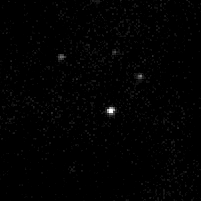Astronomy:7166 Kennedy
 Kennedy imaged by LONEOS in October 2004 | |
| Discovery [1] | |
|---|---|
| Discovered by | E. Bowell |
| Discovery site | Anderson Mesa Stn. |
| Discovery date | 15 October 1985 |
| Designations | |
| (7166) Kennedy | |
| Named after | Malcolm Kennedy [2] (Astronomical Society of Glasgow) |
| 1985 TR · 1976 JA10 1991 HC5 · 1992 OZ8 | |
| Minor planet category | main-belt · (inner) Nysa [3] · background [4] |
| Orbital characteristics [1] | |
| Epoch 4 September 2017 (JD 2458000.5) | |
| Uncertainty parameter 0 | |
| Observation arc | 62.93 yr (22,986 days) |
| |{{{apsis}}}|helion}} | 2.7579 AU |
| |{{{apsis}}}|helion}} | 2.1036 AU |
| 2.4307 AU | |
| Eccentricity | 0.1346 |
| Orbital period | 3.79 yr (1,384 days) |
| Mean anomaly | 105.04° |
| Mean motion | 0° 15m 36.36s / day |
| Inclination | 3.7053° |
| Longitude of ascending node | 14.082° |
| 64.060° | |
| Physical characteristics | |
| Dimensions | 4.42 km (calculated)[3] 5.129±0.149 km[5][6] |
| Rotation period | 3.659±0.0011 h[7] |
| Geometric albedo | 0.21 (assumed)[3] 0.267±0.048[5][6] |
| S [3][8] | |
| Absolute magnitude (H) | 13.5[6] · 13.633±0.003 (R)[7] · 13.8[1] · 14.06±0.23[8] · 14.08[3] |
7166 Kennedy, provisional designation 1985 TR, is a stony Nysian asteroid from the inner regions of the asteroid belt, approximately 5 kilometers in diameter. It was discovered on 15 October 1985, by American astronomer Edward Bowell at Lowell's Anderson Mesa Station near Flagstaff, Arizona, in the United States.[9] The asteroid was named after Malcolm Kennedy of the Astronomical Society of Glasgow.[2]
Orbit and classification
Kennedy is a member of the Nysa family (405), the largest asteroid family of the main belt, consisting of stony and carbonaceous subfamilies. The family, named after 44 Nysa, is located in the inner belt near the Kirkwood gap (3:1 orbital resonance with Jupiter), a depleted zone that separates the central main belt.[3] It is, however, a non-family asteroid from the main belt's background population when applying the hierarchical clustering method to its proper orbital elements.[4]
It orbits the Sun in the inner main-belt at a distance of 2.1–2.8 AU once every 3 years and 9 months (1,384 days). Its orbit has an eccentricity of 0.13 and an inclination of 4° with respect to the ecliptic.[1] The body's observation arc begins with a precovery taken at Palomar Observatory in June 1954, more than 31 years prior to its official discovery observation at Anderson Mesa.[9]
Physical characteristics
Kennedy has been characterized as a common stony S-type asteroid by PanSTARRS photometric survey.[8]
Rotation period
In December 2012, a rotational lightcurve of Kennedy was obtained from photometric observations in the R-band by astronomers at the Palomar Transient Factory in California. Lightcurve analysis gave a rotation period of 3.659 hours with a brightness amplitude of 0.52 magnitude ({{{1}}}).[7]
Diameter and albedo
According to the survey carried out by the NEOWISE mission of NASA's Wide-field Infrared Survey Explorer, Kennedy measures 5.129 kilometers in diameter and its surface has an albedo of 0.267,[5][6] while the Collaborative Asteroid Lightcurve Link assumes an albedo of 0.21 and calculates a diameter of 4.42 kilometers based on an absolute magnitude of 14.08.[3]
Naming
This minor planet was named in memory of Malcolm Kennedy (1944–1997), secretary of the Astronomical Society of Glasgow. He was born and raised in New Zealand and became a civil engineer in Scotland.[2] The official naming citation was published by the Minor Planet Center on 8 August 1998 (M.P.C. 32348).[10]
References
- ↑ 1.0 1.1 1.2 1.3 "JPL Small-Body Database Browser: 7166 Kennedy (1985 TR)". Jet Propulsion Laboratory. https://ssd.jpl.nasa.gov/sbdb.cgi?sstr=2007166.
- ↑ 2.0 2.1 2.2 Schmadel, Lutz D. (2007). "(7166) Kennedy". Dictionary of Minor Planet Names – (7166) Kennedy. Springer Berlin Heidelberg. p. 580. doi:10.1007/978-3-540-29925-7_6328. ISBN 978-3-540-00238-3.
- ↑ 3.0 3.1 3.2 3.3 3.4 3.5 3.6 "LCDB Data for (7166) Kennedy". Asteroid Lightcurve Database (LCDB). http://www.minorplanet.info/PHP/generateOneAsteroidInfo.php?AstInfo=7166%7CKennedy.
- ↑ 4.0 4.1 "Asteroid 7166 Kennedy – Proper Elements". AstDyS-2, Asteroids – Dynamic Site. https://newton.spacedys.com/astdys/index.php?pc=1.1.6&n=7166.
- ↑ 5.0 5.1 5.2 Masiero, Joseph R.; Mainzer, A. K.; Grav, T.; Bauer, J. M.; Cutri, R. M.; Dailey, J. et al. (November 2011). "Main Belt Asteroids with WISE/NEOWISE. I. Preliminary Albedos and Diameters". The Astrophysical Journal 741 (2): 20. doi:10.1088/0004-637X/741/2/68. Bibcode: 2011ApJ...741...68M. http://adsabs.harvard.edu/cgi-bin/bib_query?bibcode=2011ApJ...741...68M. Retrieved 5 October 2017.
- ↑ 6.0 6.1 6.2 6.3 Mainzer, A.; Grav, T.; Masiero, J.; Hand, E.; Bauer, J.; Tholen, D. et al. (November 2011). "NEOWISE Studies of Spectrophotometrically Classified Asteroids: Preliminary Results". The Astrophysical Journal 741 (2): 25. doi:10.1088/0004-637X/741/2/90. Bibcode: 2011ApJ...741...90M.
- ↑ 7.0 7.1 7.2 Waszczak, Adam; Chang, Chan-Kao; Ofek, Eran O.; Laher, Russ; Masci, Frank; Levitan, David et al. (September 2015). "Asteroid Light Curves from the Palomar Transient Factory Survey: Rotation Periods and Phase Functions from Sparse Photometry". The Astronomical Journal 150 (3): 35. doi:10.1088/0004-6256/150/3/75. Bibcode: 2015AJ....150...75W. http://adsabs.harvard.edu/cgi-bin/bib_query?bibcode=2015AJ....150...75W. Retrieved 5 October 2017.
- ↑ 8.0 8.1 8.2 Veres, Peter; Jedicke, Robert; Fitzsimmons, Alan; Denneau, Larry; Granvik, Mikael; Bolin, Bryce et al. (November 2015). "Absolute magnitudes and slope parameters for 250,000 asteroids observed by Pan-STARRS PS1 - Preliminary results". Icarus 261: 34–47. doi:10.1016/j.icarus.2015.08.007. Bibcode: 2015Icar..261...34V. http://adsabs.harvard.edu/cgi-bin/bib_query?bibcode=2015Icar..261...34V. Retrieved 5 October 2017.
- ↑ 9.0 9.1 "7166 Kennedy (1985 TR)". Minor Planet Center. https://www.minorplanetcenter.net/db_search/show_object?object_id=7166.
- ↑ "MPC/MPO/MPS Archive". Minor Planet Center. https://www.minorplanetcenter.net/iau/ECS/MPCArchive/MPCArchive_TBL.html.
External links
- Asteroids related to the Astronomical Society of Glasgow, archived website
- Find 7166 Kennedy in the night sky
- Asteroid Lightcurve Database (LCDB), query form (info )
- Dictionary of Minor Planet Names, Google books
- Asteroids and comets rotation curves, CdR – Observatoire de Genève, Raoul Behrend
- Discovery Circumstances: Numbered Minor Planets (5001)-(10000) – Minor Planet Center
- 7166 Kennedy at AstDyS-2, Asteroids—Dynamic Site
- 7166 Kennedy at the JPL Small-Body Database
 |

